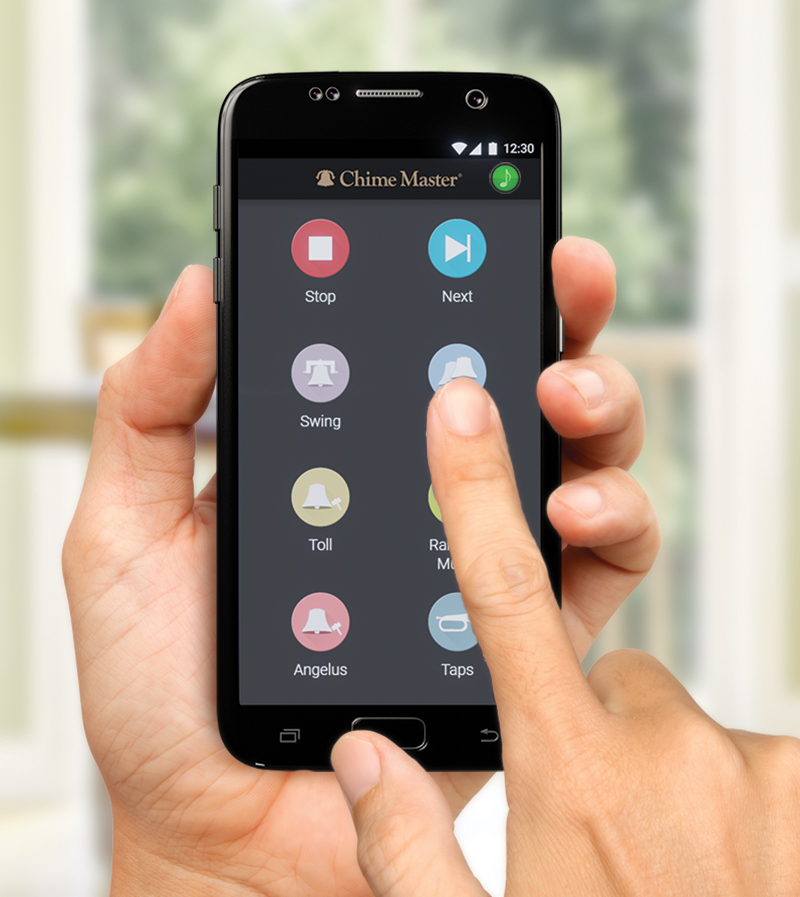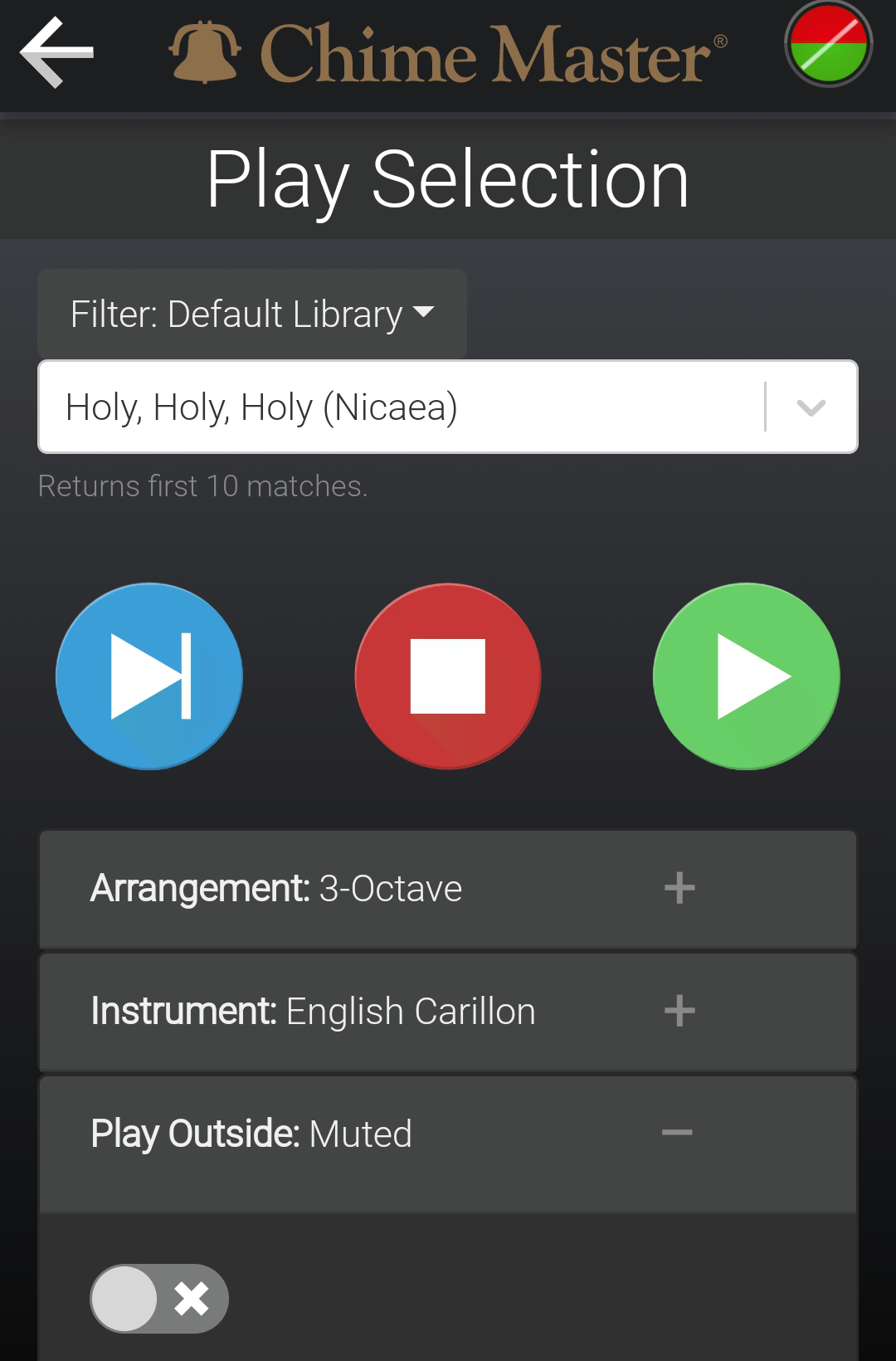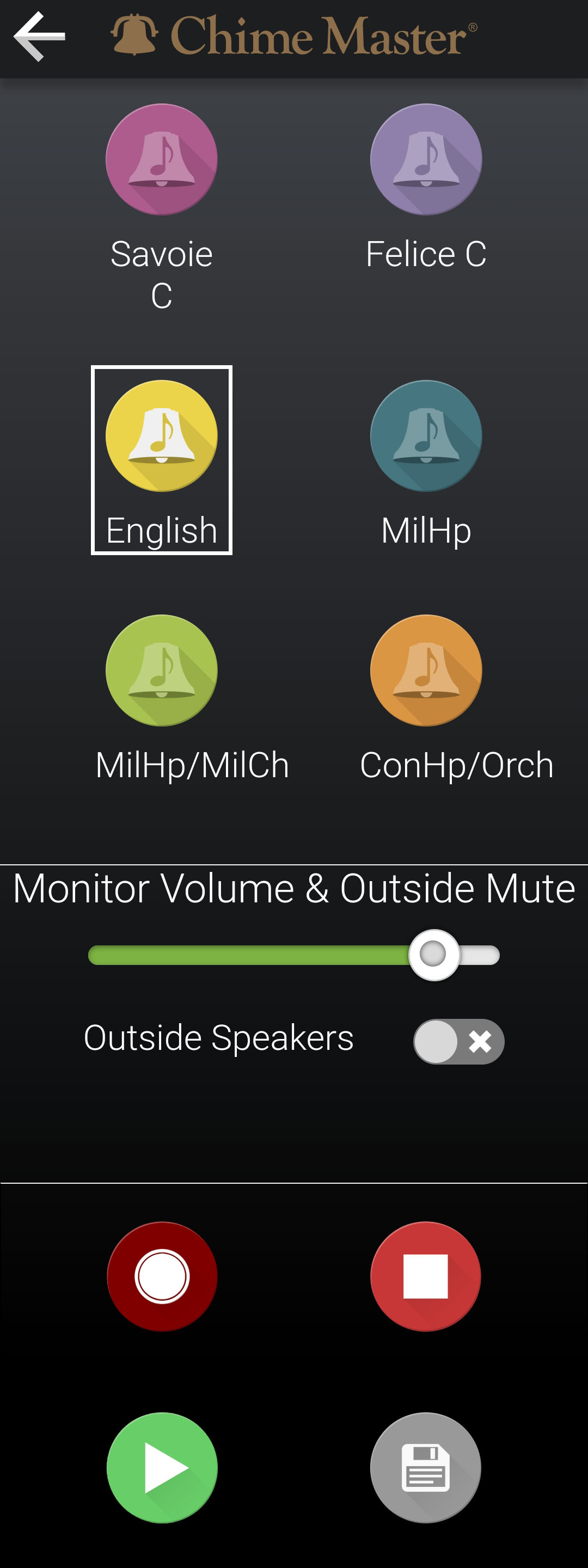Remote AX
The Chime Master AX Remote control finally brings immediate, frustration free and secure control to the bell ringing world. Provided your bell ringing system has an Internet connection and your phone or tablet also has a good carrier broadband or WiFi data connection, one scan of a QR code will provide control of the system anywhere you go. Not everyone has Internet at their church, so we've provided alternative solutions for the same functionality when you are close to the carillon.
The remote control provides the quick function buttons on each user’s customized home screen. Alternatively, log in to Chime.Center from a tablet or PC to manage your ringing schedule, individualized user's access and other settings. Contact our customer service representatives to help you set up your account at 800-432-3977.
Setup
No app store download required!
This section assumes that both the bell system and your phone/tablet are connected to the Internet.
If you do not have Internet access, use Network Settings to enable the ringing system's Access Point mode, then follow AP instructions below.
Obtain a secure access QR code
Scroll down to and tap the Remote button on the system's touch screen. Enter the PIN code of the user for whom you are installing the remote. The displayed Quick Response (QR) code has the secure information needed to load the remote for the selected user. Scan the code with your phone or tablet to load the remote control page on your device.
If you are not able to get to the system to scan the code on the front screen, you can get the code when you log into Chime.Center and select Remote Code from the Settings menu. If the screen is on your computer, use your phone's camera to scan the code. If you log into Chime.Center on your phone, tap the Open remote in browser button.
Scanning the code
Open the appropriate barcode scanning app, point the camera at the code and click on the notification link that pops up when the code is recognized.
Sometimes the device camera will read the code more reliably when the system screen is dimmed. Click the front panel power button (the gold light) to dim the screen if unable to scan at full brightness.
When you click the link that pops up after scanning the code, your browser will load your home screen served by the Chime.Center web portal. Use your browser's menu to save the remote control to your phone's home screen. You will be able to use your phone to control the bell system from anywhere you have an Internet connection.
Apple
iOS 11 or newer can scan the code with the camera app. Launch the Camera app, point at the code and look for a notification at the top of the screen. Other QR code apps are available in the App Store for older phones and tablets.
Android
Android 12 or newer can scan the code with the camera app. Many Android devices can use either a manufacturer's supplied scanning app or Google Lens to scan the code. Lens is available in Assistant if Google Photos is installed. New Android releases may have the camera search Lens icon at the right of the search widget.
Touch and hold the home button on older Android phones to launch assistant and look for the Lens icon (camera with dot on lower right). Other QR code apps are available in the Play Store if needed.
Save to home screen
The first use of the remote app will be in your phone's browser. If you use your browser's Add To Home feature, it may appear on the home screen, or it may appear in your listing of all apps (from where you can drag it out to a home screen). If your secure authentication expires, you will need to update it by scanning a new QR Code on the bell ringing system.
Apple only allows Safari to add to home screen. If you have another browser set as default, you can bookmark the remote. We suggest that you temporarily set your default browser to Safari and add the remote to your home screen, then change your Settings to your preferred browser.
Samsung phones and possibly others may not allow you to save to home screen unless the home screen layout is unlocked. To unlock your phone's home screen, tap and hold in an empty area of the screen. On the popup menu, tap settings. Turn off Lock Home Screen Layout.
Functionality
Your home screen will now be available on your phone or tablet to activate quick functions for music and ringing. You can create and edit these quick functions using Settings - Customize Home menu.
Status
The status icon at the top right of the display shows the system status.
Launching the remote app immediately wakes the audio system, but it takes a few seconds for the amplifiers to be ready to play. If you initiate ringing before the amplifiers are ready, you will experience a delay before ringing begins.
Closing the app screen starts a five minute timeout after which the amplifier will return to sleep mode.
Play Selection
Tap the Play Selection button to play a specific song or ringing selection. Use your phone keyboard to enter a word or phrase to search for and up to ten matches will be returned. Tap the desired selection in the search list to put its full title in the search bar and close the list.
You can tap the green Play button at this point and the system will use your music style preferences to play the title. If you want to choose from other available arrangement and instrumentation options, use the selectors on the lower part of the screen before tapping Play.
You may also turn off outside speaker zones so you can audition arrangements and instruments through your inside speakers without broadcasting the selections.
While a selection is playing you can select additional titles or styles to play. When you tap the play button again the selection is added to the queue. You can skip from the currently playing selection to the next selection in the queue by tapping the blue Next button. Tapping the red Stop button will clear the queue and stop playing.
Return to the remote home screen by tapping the upper right back button.
Keyboard
The remote for Millennium and Platinum models will have a Keyboard button. Tap the button to enable the system's MIDI input and bring up the keyboard remote page.
The keyboard page provides you with practice and performance features. The keyboard will play inside only by default, but you can switch on outside zones if desired. You can record, save and title your recordings, all within this app. This is especially helpful if your organ or keyboard is not right next to your bell system.
Keyboard control on the app is similar to the keyboard page on the system's touch screen. Entering Keyboard will stop anything that is currently playing and suspend the automatic schedule and disable quick functions while it is open. The status icon at the top right of the system's touch screen will show that it is in the keyboard mode.
The recording controls are at the bottom of the page and may require that you scroll down to reveal them.
- Record
- Press the red button with the white circle to begin recording
- Playback
- Press the green button with the play arrow to listen to your recording
- Stop
- Press the red button with the white square to stop playback
- Save
- Press the gray button with the disk icon to save your recording
Be sure to tap the back button to close Keyboard mode and allow the schedule to resume. Otherwise, the keyboard timeout will be in effect (one hour default after the last note played).
If you wish to change the six voices available to you on the app, you can edit them on the touch screen Keyboard menu by tapping Instruments under Settings.
Return to the remote home screen by tapping the upper right back button.
Update your remote
If you customize your home screen or the system receives updated firmware, your phone remote will not automatically update.
The remote control version number is displayed at the bottom right of the remote home screen. Simply tap on the version number to reload the latest version of the remote or to update the custom home screen.
Limited connectivity modes
Without an Internet connection there are two alternate ways to control the system. This is easier for some phones and tablets than others because the phone will continually 'hunt' for Internet access. Without Internet updates, your local remote control screen may lack all of the functionality described above.
Refer to the network settings page for instructions for WiFi or Access Point configurations.
Local Area Network
If the system detects that it is connected to a local area network, without an Internet connection, it will attempt to serve the home screen to that network. The phone or tablet must be connected to the same network to find the carillon. Contact your system administrator to select the SSID and password to connect to this network. You will only be able to access the system when near the WiFi antenna for this network (in the same building).
A downside to this method is that occasionally the bell system will receive a new IP address from the network. When this happens, a saved remote app icon will no longer reach the system. When the IP address changes, the system will provide a new code on the remote page to scan.
Access Point
If no network is available, you can still connect to the AX system for remote control. When the supplied WiFi adapter antenna is installed, and not connected to another WiFi network, you can enable the bell system's Access Point (AP) mode to provide a local remote.
The Remote Setup screen will display this SSID and password for you to set your phone for connection. Once you have successfully connected to the carillon WiFi, scan the code with your phone or tablet to load the remote screen. Some phones or tablets may require you to confirm that you wish to connect to a network without internet, before it will complete the connection to the carillon WiFi.
- Note
- The QR code information when using the ringing system's local network is different than the one provided when the system is on the Internet. If later you connect the system to the Internet, you will need to scan the Chime.Center remote code as described above.
Remote privileges
The administrator(s) can limit a user's privileges and set restricted access times during which the remote control will refuse connections.


